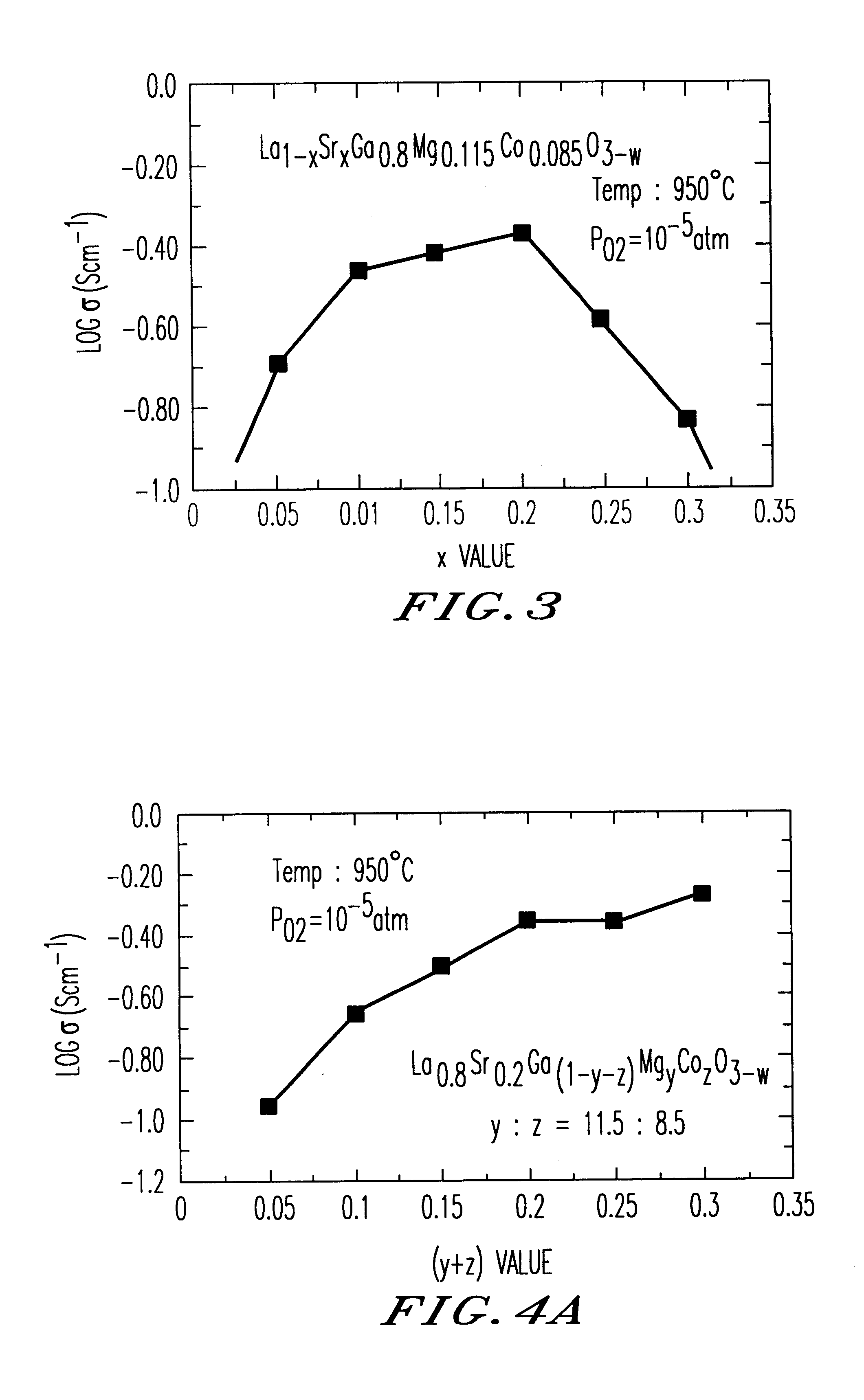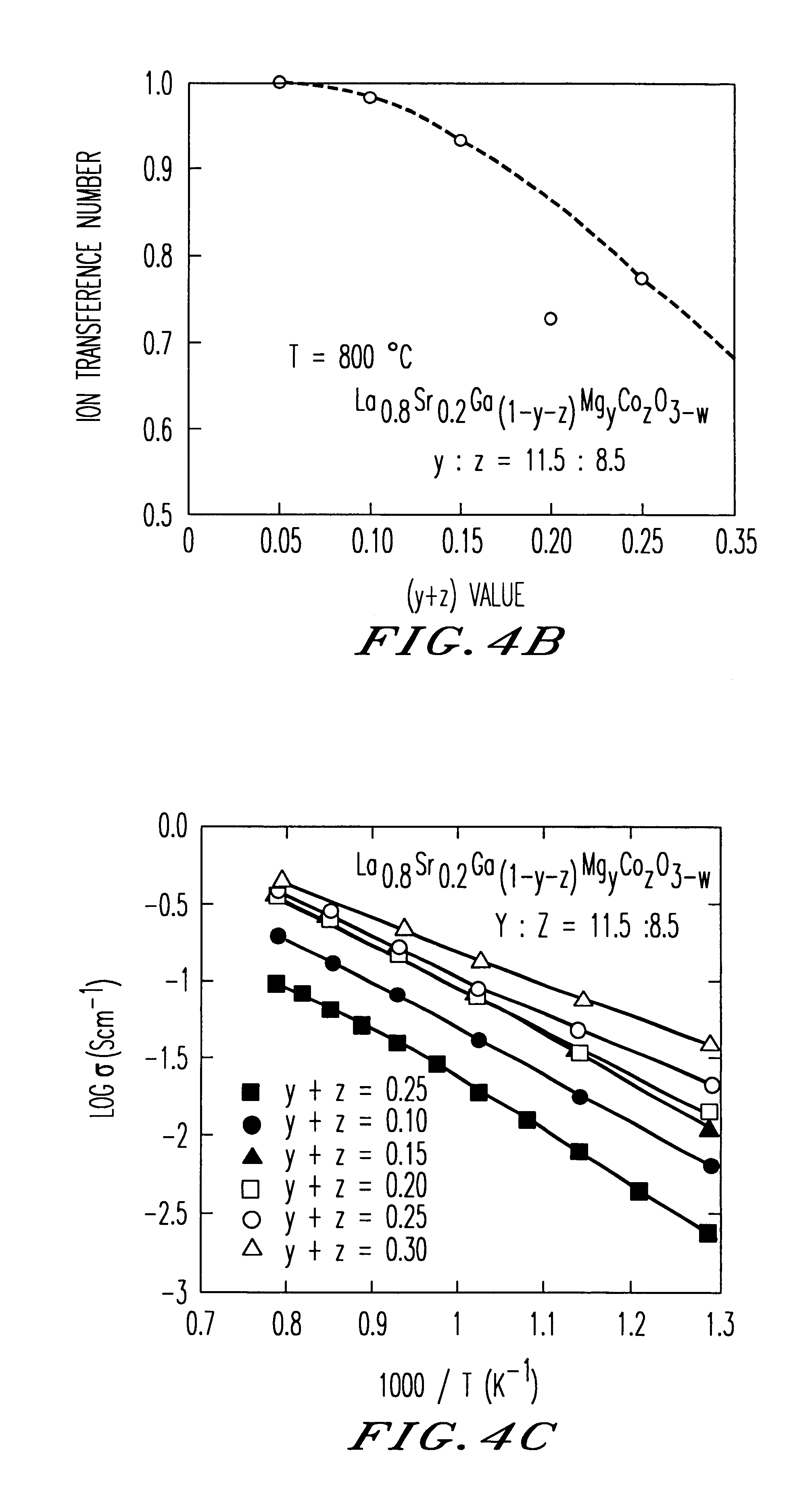Oxide-ion conductor and use thereof
a gallate oxide and conductor technology, applied in the field of rare earth gallate oxideion conductors, can solve the problems that known conductors cannot be used as the material of solid oxide fuel cells, cannot be used practically as oxide-ion conductors, etc., and achieve the effect of improving the oxide-ion conductivity and the oxide-ion conductivity
- Summary
- Abstract
- Description
- Claims
- Application Information
AI Technical Summary
Benefits of technology
Problems solved by technology
Method used
Image
Examples
example 1
Powders were prepared from La2O3, SrCO3, Ga2O3, MgO and one or more transition metal oxides selected from CoO, Fe2O3, Ni2O3, CuO and MnO2. These powders were mixed to provide a composition expressed by La0.8Sr0.2Ga0.8Mg0.1M0.1O3−w (“M” being a transition metal). After sufficient blending, the mixture was pre-heated at 1000° C. for 6 hours. The pre-heated mixture was then crushed and compression-formed into disks 0.5 mm thick and 15 mm diameter, by means of a isostatic press, and the disks thus formed were sintered by being heated at 1500° C. for 6 hours. The crystal structures of the sintered disks were examined by means of X-ray diffraction and confirmed to have the perovskite structure.
Electrical conductivity of the sintered body was examined as follows. Rectangular parallelepiped test pieces were cut out from the disk-shaped sintered bodies. After application of a platinum paste as electrodes, platinum wires were connected to each test piece, followed by heating at temperatures v...
example 2
Test pieces of oxide-ion conductor was produced from a sintered body of La0.8Sr0.2Ga0.8Mg0.115CO0.085O3−w in the same manner as Example 1 and were subjected to measurement of electrical conductivity at varying temperature under a fixed oxygen partial pressure of 10−5 atm. The results of the measurement (Arrhenius plot of conductivity) are shown in FIG. 11.
example 3
Test pieces of oxide-ion conductor were produced from a sintered body of La1−xSrxGa0.8Mg0.115Co0.085O3−w (x=0.1, 0.15, 0.2, 0.25 or 0.3) in the same way as Example 1 and were subjected to measurement of electrical conductivity at varying temperature under a fixed oxygen partial pressure or at a fixed temperature under varying oxygen partial pressure. FIG. 3 shows the relationship between the value of “x” and the electrical conductivity as observed at 950° C. The Arrhenius plot of conductivity (oxygen partial pressure 10−5 atm) and the oxygen-partial-pressure dependence of the electrical conductivity (at 950° C.) are respectively shown in FIGS. 12A and 12B. It will be noted that the oxygen-partial-pressure dependence of conductivity varies according to the “x” value.
PUM
| Property | Measurement | Unit |
|---|---|---|
| Electrical conductivity | aaaaa | aaaaa |
| Electrical conductor | aaaaa | aaaaa |
| Thermal resistance | aaaaa | aaaaa |
Abstract
Description
Claims
Application Information
 Login to View More
Login to View More - R&D
- Intellectual Property
- Life Sciences
- Materials
- Tech Scout
- Unparalleled Data Quality
- Higher Quality Content
- 60% Fewer Hallucinations
Browse by: Latest US Patents, China's latest patents, Technical Efficacy Thesaurus, Application Domain, Technology Topic, Popular Technical Reports.
© 2025 PatSnap. All rights reserved.Legal|Privacy policy|Modern Slavery Act Transparency Statement|Sitemap|About US| Contact US: help@patsnap.com



